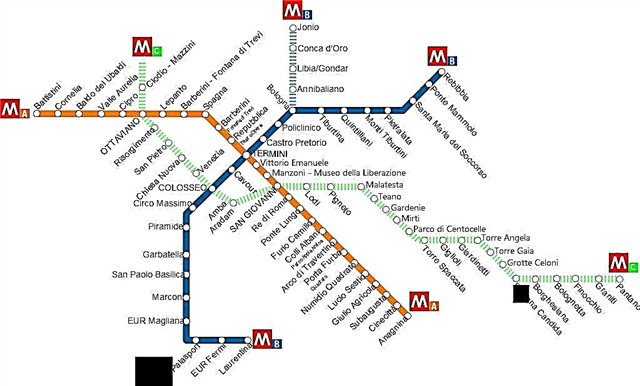The Rome Metro is the youngest in Europe. Its construction began in the 30s of the last century, but during the Second World War, construction work was stopped. In 1948, the construction of the subway began again, and in 1955, an 11 km launch section was laid, linking the TERMINI and LAURENTINA stations. For all 60 years of operation, the passenger traffic of the Roman metro has amounted to more than 270 million people.
Metro map

Such efficient operation of the metro is explained by the simplicity and availability of its use. The Rome metro includes three branches: the very first blue - B, orange - A, as well as line C. The last line was laid relatively recently in 2012 and covers only 4 stations.
Line B covers 22 stations and stretches from the northeast to the southwest of the Italian capital. Line A has been operating since 1980 and includes 27 stations. Lines A and B intersect at Termini Central Station. Here you can transfer from one metro line to another. In the future, it is planned to increase the number of stations on the C line and extend this line outside the city. It is planned to build another thirty metro stations in the near future.
Weak ramification is due to the presence of ancient archaeological values found during the construction of tunnels. Therefore, the construction of the Roman metro is often accompanied by archaeological excavations. It is noteworthy that many metro stations are located on the surface and resemble the platforms of ordinary commuter trains. Therefore, sometimes it is not possible to transfer from the same platform in the opposite direction. In this case, you need to go through the turnstiles with a new ticket.

Colosseum, Roman Forum, Palatine Hill with one ticket
Time entrance to St. Peter's Basilica with audio guide
Fast track entry to the Vatican Museums and Sistine Chapel
Borghese Gallery: Reserved Entrance Ticket
Skip-the-line: Museums, Sistine Chapel, St. Peter's Basilica
Rome: hop-on hop-off sightseeing bus tour
Rome bus ticket: 24, 48 or 72 hours
St. Peter's Basilica with Dome Climb and Crypt Visit
How to buy and use a ticket: instructions
A distinctive feature of the Roman metro is the fact that it includes not only underground lines, but also ordinary surface trains. Such a system was created for the convenience of passengers, since with one ticket you can travel by train of any type. In addition, such a universal ticket can be purchased at almost any kiosk. The safest way to buy a ticket is from special machines at the entrance to the metro.
Once you have validated such a ticket, for the next 100 minutes you can use it on any type of transport, whether it be an electric train, bus or tram, moving within the same zone. The time is counted from the moment of composting. Therefore, it is most convenient for tourists to buy a ticket at the airport, so as not to waste time buying it, but to immediately go on a trip around the Italian capital. However, if you need to change your route and use the subway again, you will have to buy your ticket again. It is worth noting that children under ten years old can ride for free.
In Rome, a new, more convenient ticketing system has been introduced. Now you can buy a ticket and use all types of city transport for the time specified in it. The cost of such a ticket depends on the time of use. You can optionally purchase a ticket not only for 100 minutes, but also for 24, 48 and 72 hours, as well as for a longer period of 7 days. For tourists, such tickets are very convenient, since, having spent only one time, you can safely drive around the Eternal City and not worry about having a travel document every time.
How to get around on the subway
The ease of movement on the Roman metro also lies in the ease of use of the metro lines scheme. All stations near which the sights of the Italian capital are located have corresponding names. If you, for example, decide to visit the Colosseum, then look for the station with the same name. On the scheme of the Roman metro, the location of the stations is oriented in the same way as on the ground. If the Fiumicino airport is located in the south-west of Rome, then on the metro map it should be looked for at the bottom left.
Metro opening hours
The Rome Metro starts its work at 5.30 and closes depending on the day of the week. On Saturdays and Fridays, the work of underground highways stops at 00.30, and on other days the metro closes at 23.30.

City trains arrive at destination stations every 10 to 15 minutes. Tourists should take into account that the movement of surface trains ends earlier than the operation of underground trains. Before Giardinetti, for example, ground trains run only until the beginning of 23.00. If you intend to go to the famous Lido beach, it should be borne in mind that only on Fridays, trains run in this direction until 00.00, and on other days they stop working at 23.30.
In Rome, as in any European city, there can be strikes by public transport workers, which negatively affects movement in the city. Therefore, the metro may be the best option for a tourist who wants to travel independently around Rome.











